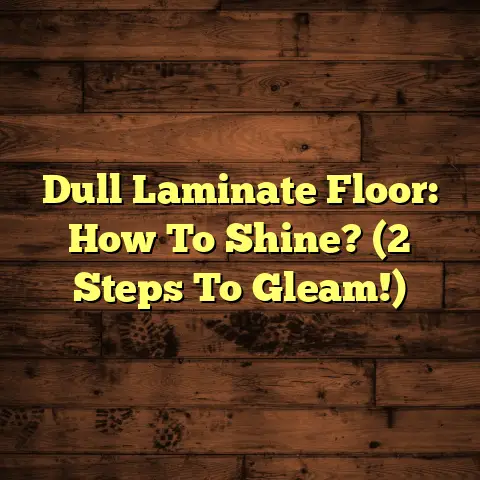Polish on Laminate? (3 Things You Must Know!)
Laminate flooring has become a go-to choice, hasn’t it?
It’s affordable,
looks great, and is relatively easy to care for.
The feeling of a clean,
well-maintained laminate floor underfoot is a simple pleasure.
But let’s be real, we all want that extra oomph, that showroom shine.
That’s
where the idea of polishing comes in.
Today, we’re diving deep into the world
of laminate and polish.
Let’s get started!
1: Understanding Laminate Flooring
1.1 What is Laminate Flooring?
Laminate flooring is like a high-tech sandwich.
It’s made of multiple layers
fused together.
These layers typically include:
- Wear Layer: This is the top layer, a clear, protective coating that resists scratches, stains, and fading.
- Decorative Layer: This is where the magic happens.
A high-resolution photograph of wood, stone, or tile is printed on this layer, giving the laminate its realistic appearance. - Core Layer: Usually made of high-density fiberboard (HDF) or medium- density fiberboard (MDF), this layer provides stability and impact resistance.
- Backing Layer: This bottom layer provides a moisture barrier and helps prevent warping.
Think of it like this: the decorative layer is the face, the core layer is the backbone, and the wear layer is the bodyguard.
1.2 Advantages of Laminate Flooring
Why is laminate so popular? Well, let’s look at some of its perks:
- Affordability: Compared to hardwood or tile, laminate is much easier on the wallet.
- Durability: That wear layer is tough!
It can handle everyday wear and tear, making it great for families with kids and pets. - Easy Installation: Many laminate floors come with a click-lock system,
making DIY installation a breeze.
I’ve even seen clients install it themselves with minimal experience. - Low Maintenance: Regular sweeping and occasional mopping are usually all it takes to keep laminate looking its best.
- Variety: The decorative layer offers endless possibilities.
You can find laminate that mimics virtually any type of wood, stone, or tile.
1.3 Popular Uses for Laminate Flooring
Laminate is versatile. Here are some common places where you’ll find it:
- Living Rooms: Laminate provides a comfortable and stylish surface for family gatherings and relaxation.
- Bedrooms: Its warmth and durability make it a great choice for bedrooms.
- Kitchens: While not waterproof, water-resistant laminate options are
available for kitchens.
Just be sure to clean up spills quickly! - Basements: Laminate can be a good option for basements, especially if you choose a moisture-resistant variety.
2: The Role of Polish in Laminate Care
2.1 What is Floor Polish?
Floor polish is a liquid product designed to add a protective layer and shine
to flooring surfaces.
It’s typically made of polymers, waxes, and solvents.
Polishes are used to:
- Enhance Shine: Give floors a glossy, reflective appearance.
- Protect the Surface: Provide a barrier against scratches, scuffs, and stains.
- Restore Appearance: Help rejuvenate older floors that have lost their luster.
Floor polish is commonly used on hardwood, tile, and linoleum floors.
But
what about laminate?
That’s where things get tricky.
2.2 Common Misconceptions About Polishing Laminate
Here’s the truth: Laminate flooring is generally not designed to be polished. Let me repeat that: not designed to be polished.
Why?
Because laminate already has a protective wear layer.
Applying polish
can actually damage this layer, leading to a dull, cloudy appearance.
It can
also create a slippery surface, which is a safety hazard.
I’ve had homeowners tell me, “But I want my laminate to shine like hardwood!”
I get it.
But laminate and hardwood are different animals.
Laminate’s shine
comes from its wear layer, not from polish.
2.3 Benefits of Using Polish on Laminate Floors
Okay, I’ve said that polishing laminate is generally a bad idea.
But are there
any potential benefits?
- Enhanced Shine (Maybe): In some cases, a very thin layer of polish
might temporarily enhance the shine.
But this is a short-term fix and can lead to long-term problems. - Protection (Doubtful): Polish might offer a slight additional
layer of protection against minor scratches.
But again, the wear layer is already designed for this purpose. - Aesthetic Appeal (Subjective): Some people simply like the look of
polished floors.
But is it worth the risk of damaging your laminate?
Honestly, the potential benefits are minimal and outweighed by the risks.
I
usually advise my clients to steer clear of polish altogether.
3: Key Considerations Before Polishing Laminate
3.1 The Type of Laminate Flooring Matters
Not all laminate is created equal. Here’s what to consider:
- Embossed vs.
Smooth: Embossed laminate has a textured surface that mimics the grain of wood or stone.
Polish can get trapped in these grooves, making it difficult to remove and creating a dull appearance. - Thickness: Thicker laminate floors tend to be more durable and
resistant to damage.
However, even thick laminate can be damaged by polish. - Wear Layer: The thickness and quality of the wear layer vary between
different laminate products.
A thinner wear layer is more susceptible to damage from polish. - Water Resistance: Some laminate floors are more water-resistant than
others.
Polish can compromise the water resistance of these floors.
Before even thinking about polish, check the manufacturer’s recommendations
for your specific laminate flooring.
They’ll usually advise against it.
3.2 Risks of Polishing Laminate Floors
Let’s talk about the potential downsides of polishing laminate:
- Damage to the Wear Layer: Polish can react with the wear layer, causing
it to become cloudy, dull, or even peel.
This can ruin the appearance of your floors. - Slippery Surface: Polish can create a slick surface, increasing the
risk of slips and falls.
This is especially dangerous for children and the elderly. - Residue Buildup: Polish can build up over time, creating a sticky, unattractive residue that’s difficult to remove.
- Difficulty Removing: Once polish is applied, it can be a pain to
remove.
You may need to use harsh chemicals or even hire a professional. - Voiding Warranty: Applying polish can void your laminate flooring’s warranty.
I’ve seen firsthand the damage that polish can do to laminate.
It’s not a
pretty sight.
Trust me, it’s better to avoid it altogether.
3.3 Alternative Maintenance Solutions
So, how do you keep your laminate floors looking their best without polish?
Here are some tried-and-true methods:
- Regular Sweeping/Vacuuming: This removes dirt and debris that can scratch the surface.
- Damp Mopping: Use a microfiber mop and a laminate-specific cleaner.
Avoid using too much water, as this can damage the core layer. - Spot Cleaning: Clean up spills immediately to prevent staining.
- Use Doormats: Place doormats at entrances to trap dirt and moisture.
- Avoid Abrasive Cleaners: These can scratch the wear layer.
- Protect Furniture Legs: Use felt pads on furniture legs to prevent scratches.
Here’s a simple cleaning routine I recommend to my clients:
- Sweep or vacuum the floors to remove loose dirt and debris.
- Prepare a cleaning solution by mixing a laminate-specific cleaner with water according to the manufacturer’s instructions.
- Damp-mop the floors using a microfiber mop.
Wring out the mop thoroughly to avoid over-wetting the floors. - Dry the floors with a clean, dry cloth to prevent water spots.
Conclusion
So, can you polish laminate floors?
The answer is generally no.
While the idea
of adding extra shine and protection might be tempting, the risks outweigh
the benefits.
Polish can damage the wear layer, create a slippery surface,
and void your warranty.
Instead of polish, focus on regular cleaning and maintenance using laminate-
specific products.
This will keep your floors looking their best for years to
come.
Remember, the key to beautiful laminate flooring is proper care, not
polish.
Laminate flooring offers a blend of affordability, durability, and aesthetic
appeal that makes it a comfortable choice for any home.
By understanding its
composition and adhering to proper maintenance practices, you can ensure that
your laminate floors remain a source of comfort and pride for years to come.





